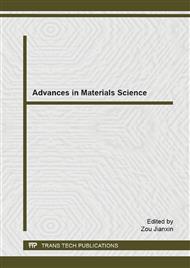p.305
p.309
p.314
p.318
p.322
p.327
p.332
p.337
p.343
Substituent Group Effete on the Geometric Configurations of the Acyclic Ruthenium Bipyridine Imidazole-Cyanide Anion Recognition Systems
Abstract:
Substituent group effete; Cyanide anion; Anion recognition; Theoretical computationAbstract. In this paper, the cyanide anion recognition of the [Ru2(bpy)4(mbpibH2)]4+ (mbpibH2 is 1, 3-bis([1, 10]-phenanthroline-[5, 6-d]imidazol-2-yl)- benzene) functional molecular material host based on hydrogen bond weak interactions was discussed by using the quantum chemistry theory and method, the density function Becke, three-parameter, Lee-Yang-Parr, DFT/B3LYP/6-31G*//SDD computational level, especially discussed the geometry structure of the recognition system. The results showed that the substituent group of Ru(bpy)2(mbpibH2) structure moieties have very important role in the recognition of the CN- anion. This study may be helpful for the further design and investigation the [Ru2(bpy)4(mbpibH2)]4+ (mbpibH2 is 1, 3-bis([1, 10]-phenanthroline-[5, 6-d]imidazol-2-yl)- benzene) involving functional molecular derivation receptors with excellent and selective anion recognition functions.
Info:
Periodical:
Pages:
322-326
Citation:
Online since:
February 2015
Authors:
Price:
Сopyright:
© 2015 Trans Tech Publications Ltd. All Rights Reserved
Share:
Citation:


